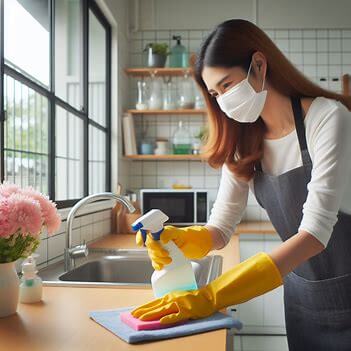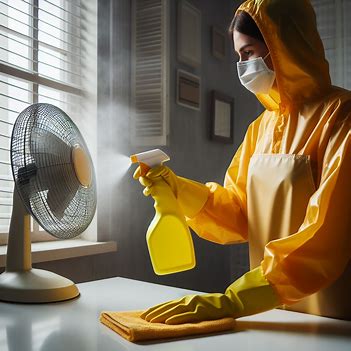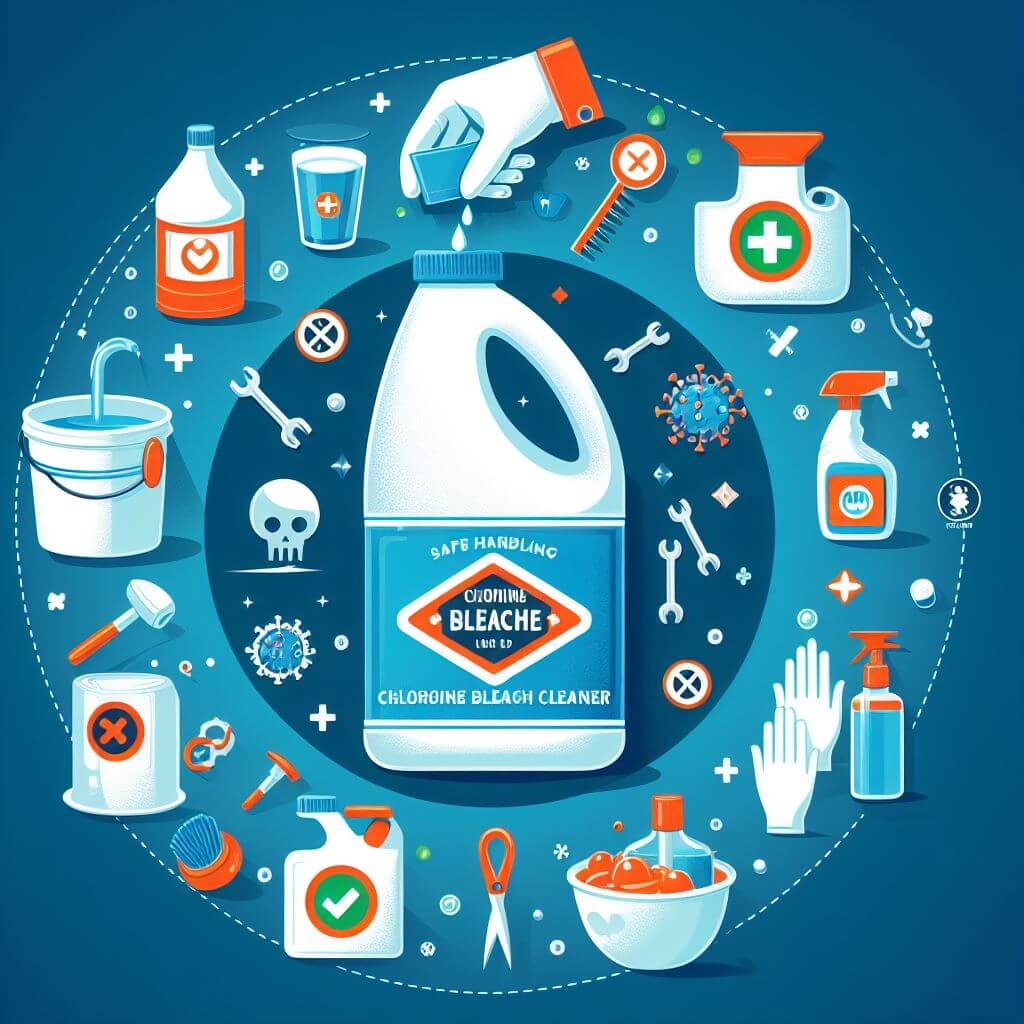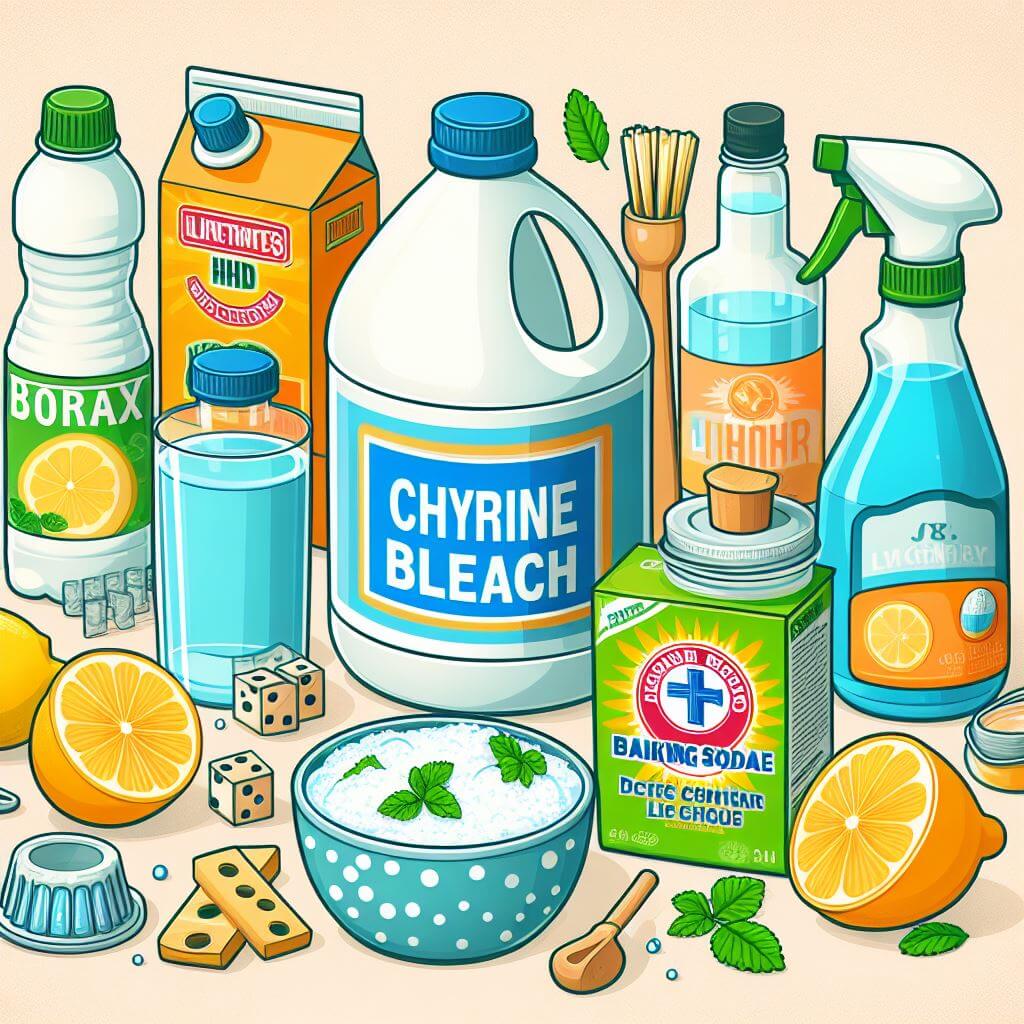- Home
- Natural Cleaning Agents
- Heath Risks Associated With Chlorine Bleach
What Are the Health Risks Associated With Chlorine Bleach: Understanding the Implications
When you use chlorine bleach, it's crucial to understand its health risks. If breathed in, the toxic gases released can harm your respiratory system, leading to irritation or damage. If it comes into contact with your skin or eyes, you might experience severe discomfort or injury. Always ensure fresh air by opening windows and doors during use, and wear protective gear to prevent contact with skin or eyes.
In case of accidental ingestion or overexposure, it's vital to act quickly. Remove contaminated clothing and seek fresh air immediately. Contact a poison control center for guidance and refer to the safety data sheet for the bleach solution you're using. Remember, using safer alternatives can significantly reduce these risks, promoting a healthier environment for you and your loved ones.
The Chemical Nature of Chlorine Bleach

Chlorine bleach, a powerful household cleaner, can pose health risks if not handled properly. When mixed with acids, such as the hydrochloric acid found in some drain cleaners, it can release chlorine gas, a toxic substance. Exposure to these toxic gases can lead to respiratory issues and other health concerns. Always consult the safety data sheet and consider using household cleaning products that are safer alternatives to bleach.
1. Breaking Down What Chlorine Bleach Is
Chlorine bleach is a water solution of sodium hypochlorite. It's widely used for its ability to disinfect and bleach, effectively killing germs and removing stains. However, it can release toxic gases if improperly mixed with other substances, posing a risk to your health. In emergencies, contacting a poison control center is crucial for advice on handling bleach exposure.
2. Common Uses and Applications of Chlorine
Household bleach is not just for making your whites whiter. It's a versatile cleaner, used in bathrooms and kitchens to kill germs, sanitize surfaces, and remove mold. Its disinfecting properties make it a staple in many homes, but understanding its potential health risks is essential for safe use.
3. How Chlorine Becomes a Health Hazard
Chlorine can become a health hazard when inhaled or comes into contact with your skin. High concentrations of chlorine can cause shortness of breath, and chest pain, and even lead to conditions like reactive airway dysfunction syndrome.
Children and those with lung diseases are at a high risk of developing severe symptoms. Signs and symptoms may develop immediately or be delayed, especially with low concentrations or diluted bleach exposure. Awareness and caution can prevent adverse health effects.
Exposure to Chlorine Bleach and Its Health Effects

Exposure to chlorine bleach, even in low concentrations, can lead to respiratory issues such as shortness of breath and chest pain. Over time, repeated exposures can increase the risk of developing lung diseases. It's crucial to recognize these risks and take preventative measures when using chlorine products.
1. Routes of Exposure to Chlorine Bleach
Understanding the treatment for chlorine bleach exposure is critical. Immediate actions can mitigate the health risks associated with accidental inhalation or skin contact.
Inhalation and Direct Contact
Chlorine gas exposure occurs when bleach is mixed with acids, releasing harmful gases. This can lead to severe respiratory issues if inhaled. Direct contact with bleach can also cause skin and eye irritation. Taking precautions and knowing how to respond to exposure can prevent serious health problems.
Consumption Through Contaminated Food and Water
While less common, ingesting contaminated food or water can lead to internal injuries. Ensuring cleanliness and proper food handling can prevent such incidents.
2. Recognizing the Symptoms of Chlorine Exposure
Identifying symptoms of chlorine exposure, such as difficulty breathing and respiratory failure, is crucial. These signs indicate that the moist tissues of the respiratory system have been affected by breathing in chlorine.
Acute Symptoms and Long-Term Health Effects
Acute exposure to chlorine can significantly impact pulmonary function. Chronic exposure to chlorine heightens the risk of long-term respiratory issues, emphasizing the importance of minimizing exposure and using protective measures.
Differential Diagnosis: Understanding Similar Symptoms
When experiencing difficulty breathing or respiratory failure after exposure to chlorine, it's vital to consider these symptoms seriously. They may indicate acute or chronic exposure to chlorine, requiring immediate medical attention.
Navigating Chlorine Exposure: Immediate and Long-Term Measures

Immediate and long-term measures are essential in navigating chlorine exposure to ensure safety and health.
1. First Response to Chlorine Exposure
Quick response to chlorine exposure can mitigate its health impacts. Identifying the exposure type and taking appropriate action is key.
Decontamination and Treatment Options
If chlorine is ingested, do not induce vomiting as this can cause further harm. Instead, seek medical advice immediately for the correct treatment to prevent serious health consequences.
When to Seek Medical Attention
If you or someone else inhales chlorine bleach, comes into direct skin contact, or swallows it, getting medical help quickly is crucial. Warning signs that need immediate medical attention include difficulty breathing, severe cough, changes in skin color, or persistent vomiting. Do not induce vomiting if the product is swallowed, as this can cause additional harm. Instead, seek professional medical assistance right away to ensure the right treatment is administered.
2. Preventing Future Exposure to Chlorine
To protect yourself and your loved ones from the risks associated with chlorine bleach, it's important to limit its use and find safer alternatives. Understanding and respecting the potential hazards of chlorine will guide you in making informed choices about its use in your home or workplace.
Safe Handling and Usage Practices
When using chlorine bleach, always wear protective gloves and ensure the area is well-ventilated to avoid inhaling fumes. Never mix bleach with ammonia or other cleaners, as this can release toxic gases. Reading and following the manufacturer's instructions for use and storage is also essential to prevent accidents and exposure. By adhering to these safety measures, you can minimize the risk of adverse health effects.
Alternatives to Using Bleach for Cleaning and Sanitizing
For those seeking safer cleaning options, alternatives like hydrogen peroxide, vinegar, or baking soda can be effective for many household tasks. Industrial settings might consider calcium hypochlorite, which, while still needing cautious handling, may offer a different risk profile than traditional bleach solutions. Exploring these alternatives can help reduce reliance on chlorine bleach while maintaining cleanliness and safety standards.
Beyond the Bleach Bottle: The Broader Implications of Chlorine Use
The use of chlorine, while effective for disinfection and sanitation, carries significant implications for both human health and the environment. By understanding the broader impacts of chlorine use, we can better appreciate the necessity of using it responsibly and exploring safer alternatives whenever possible.
1. The Impact of Chlorine on Environmental Health
Chlorine's impact on the environment is profound, with potential harm to aquatic life and water quality. When chlorine enters water bodies, it can form toxic compounds that endanger fish and other marine organisms. Recognizing these environmental risks encourages the pursuit of more eco-friendly disinfection methods
2. Community and Workplace Safety Measures
Communities and workplaces must implement safety measures to minimize chlorine exposure risks. This includes proper storage, handling training, and emergency response plans. By fostering a culture of safety and health awareness, we can protect individuals from the potential hazards associated with chlorine use.
Making Informed Choices: Alternatives to Chlorine Bleach

Exploring alternatives to chlorine bleach for cleaning and sanitizing is a step towards a safer and healthier environment. By understanding the options available, you can make informed decisions that reduce health risks without compromising cleanliness.
1. Natural and Less Harmful Cleaning Agents
Natural cleaning agents such as vinegar, baking soda, and lemon juice offer effective alternatives to chlorine bleach for many household tasks. These substances pose fewer health risks and are environmentally friendly. Adopting these natural cleaners can help reduce your exposure to hazardous chemicals.
2. Technological Advancements in Sanitization Without Chlorine
Innovations in cleaning technologies offer new ways to sanitize without relying on chlorine bleach. Ultraviolet light, for example, provides effective disinfection at room temperature and is becoming increasingly accessible for both home and industrial use. Such advancements reduce the need for chemical disinfectants, promoting a healthier environment.
Expert Insights and Further Reading on Chlorine Bleach
Gaining a deeper understanding of chlorine bleach, its uses, risks, and alternatives is essential for making informed decisions related to health and safety. Expert insights and further reading can provide valuable guidance in navigating these complex topics.
1. Enhancing Healthcare Team Outcomes
Healthcare teams play a pivotal role in managing the effects of acute exposure to chlorine bleach, including skin irritation and bleach toxicity. By staying informed about the latest treatment protocols and preventative measures, medical professionals can enhance patient care and safety in cases of chlorine exposure.
2. Additional Resources for Safe Chlorine Use and Exposure Prevention
For those seeking to learn more about safely using chlorine bleach and preventing exposure, numerous resources are available. These include guidelines on the safe storage, handling, and disposal of bleach, as well as strategies to mix bleach with water safely for disinfection purposes, ensuring safety and health in various settings.
Toward a Safer and Healthier Environment: Concluding Thoughts on Chlorine Bleach Use
As we embrace the journey toward a safer and healthier environment, it's crucial to understand the implications of chlorine bleach use. The irritating odor, corrosive nature, and potential for eye irritation are reminders of the need for cautious use.
When chlorine is released into the air, especially in low-lying areas, remember that chlorine is heavier than air, posing risks if you're exposed to chlorine gas. In case of exposure, knowing how to flush your eyes and when to call the center at 1-800-222-1222 becomes vital. Moreover, as the demand for cleaning and disinfection has increased, exploring alternatives to hypochlorite bleach and traditional cleaning agents like toilet bowl cleaners, which are non-reactive to visible light, is more important than ever.
Adopting safe handling practices and considering less harmful alternatives for cleaning and sanitizing can significantly reduce the health risks associated with chlorine bleach. By doing so, we protect not only our long-term health but also contribute to a safer environment. Let's commit to making informed choices that ensure the well-being of our communities and the planet.